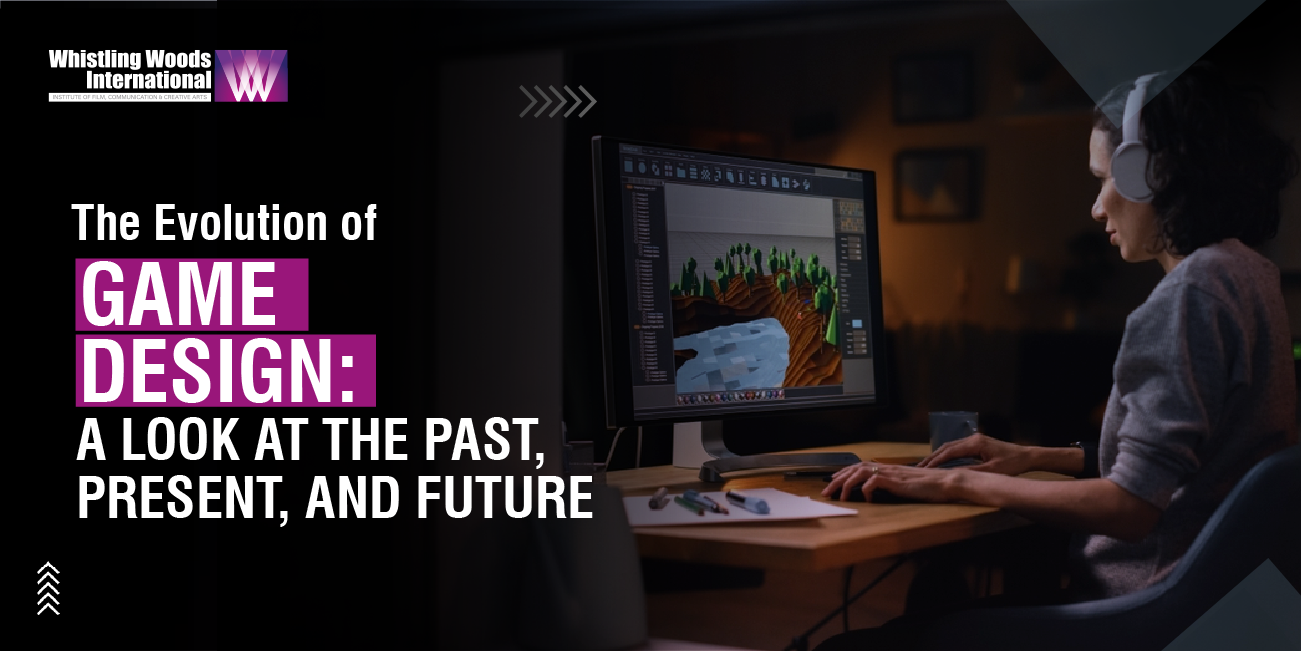Imagine stepping into a time machine, whisking you away on a thrilling adventure through the history of game design.
You’re surrounded by the mesmerising pixels of Pong, the adrenaline-pumping battles of Space Invaders, and the whimsical charm of Super Mario Bros.
As you journey through the decades, witness the rise of immersive worlds, gripping narratives, and mind-bending graphics.
Now, fast forward to the future, where virtual reality transports you to unimaginable realms, and artificial intelligence blurs the lines between reality and fiction.
The evolution of game design is an exhilarating tale of technological progress, creative ingenuity, and the unwavering passion for crafting interactive experiences that capture our hearts and minds.
In this blog, we will delve into the past, explore the present, and speculate about the future of game design, highlighting the importance of professional education to build a game design career.
Development of Game Design
The Past: The Birth of Game Design (the 2000s and earlier)
In the early days of game design in India, developers faced challenges with limited resources and technological constraints. However, they embraced these limitations and created games infused with unique tones.
Classic Indian games like “Kancha” (Marbles), “Pithoo” (Seven Stones), and “Chor Police” (Cops and Robbers) laid the foundation for the industry, captivating generations with their simplicity and cultural significance.
As technology advanced, Indian game developers explored more immersive experiences. Games like “Krish: The Game” allowed players to step into the shoes of their favourite Hindi film superhero, while titles like “Hanuman: Boy Warrior” celebrated Indian mythology, allowing players to embody the revered monkey deity in epic quests.
Educational gaming also emerged, with games like “The Great Indian Ludo” and “Quizistan” blending entertainment with learning, engaging players with Indian history, culture, and trivia.
These early experiences laid the groundwork for the flourishing and ever-evolving Indian gaming industry.
Also Check: Is Game Design A Good Career Option In India? The Surprising Truth!
The Present: Innovation and Immersion (the 2000s to the present)
In today’s game design landscape in India, innovation and immersion have played a pivotal role in propelling the industry to unprecedented heights. The advent of smartphones and the widespread availability of high-speed internet have brought about a remarkable revolution in the gaming realm.
Approximately 3 billion people worldwide play video games, and mobile gaming has become a social phenomenon, with games like “Ludo King,” “PUBG Mobile,” and “Garena Free Fire” attracting millions of players across the country.
The power of educational gaming has also been harnessed in India, with interactive quizzes and trivia challenges like “BaaziNow” and “KBC Play Along” promoting learning while entertaining players.
Esports has gained significant traction, with professional teams and tournaments showcasing Indian talent in games such as “Counter-Strike: Global Offensive” and “Dota 2.” Players compete at national and international levels, fueling the growth of competitive gaming in the country.
The convergence of game developers and the entertainment industry has fostered fruitful collaborations, bridging the gap between popular culture and gaming. It has led to the exciting adaptation of Hindi movies and TV shows into interactive experiences, creating engaging crossovers between the two dynamic worlds.
The Future: Emerging Technologies and Boundless Creativity
Virtual Reality (VR) and Augmented Reality (AR) are poised to revolutionise how Indians experience games. Imagine stepping into immersive virtual worlds inspired by Indian folklore or exploring historical landmarks through augmented reality. These technologies will transport players to unprecedented realms, providing a deeply engaging and interactive gaming experience.
The rise of cloud gaming will redefine the industry, allowing gamers to access a vast library of titles without the need for expensive hardware. This accessibility will democratise gaming, enabling a broader audience in India to experience the joy of gaming across various devices.
Artificial intelligence (AI) will enhance game design, creating dynamic and adaptive experiences. AI-powered NPCs (non-playable characters) will offer realistic interactions and behaviours, making the gaming environment more immersive and lifelike.
Procedural generation techniques will enable the creation of infinite and ever-evolving game worlds, ensuring that no two playthroughs are the same. This will enhance replayability and keep players engaged with fresh content.
Read More: A Comprehensive Guide to Animation and Game Design Career
Climb the Game Design Ladder: Stepping Up Your Future
The future of game design in India is bright, with emerging technologies and a wealth of creative talent poised to revolutionise the industry.
It is further believed that online gaming audiences will surpass 1.3 billion people by 2025.
Further, as the game design industry continues to expand, aspiring designers must receive proper education and training to stay ahead of the curve for their game design careers. Whistling Woods International, a renowned game design school, recognises the growing demand for skilled game designers and offers a comprehensive course in game design.
Our game design courses provide students with a solid foundation in game development, encompassing various aspects such as concept creation, level design, programming, and game production.
Game design course offered by us:
BDes in Game Design | (4 Years)
During the initial year of our game design course, students delve into a comprehensive curriculum that encompasses 2D/3D animation, motion graphics, graphic novel design, and video game design. As they progress into the subsequent years, the focus shifts towards project-based learning, enabling students to cultivate specialised skills that align with their interests and strengths.
Our course emphasises practical learning, encouraging students to work on real-world projects and collaborate with peers. Through hands-on experience and mentorship from industry professionals, students gain valuable insights into the game design process, preparing them for a successful career.
You can also visit our website for more course information.

